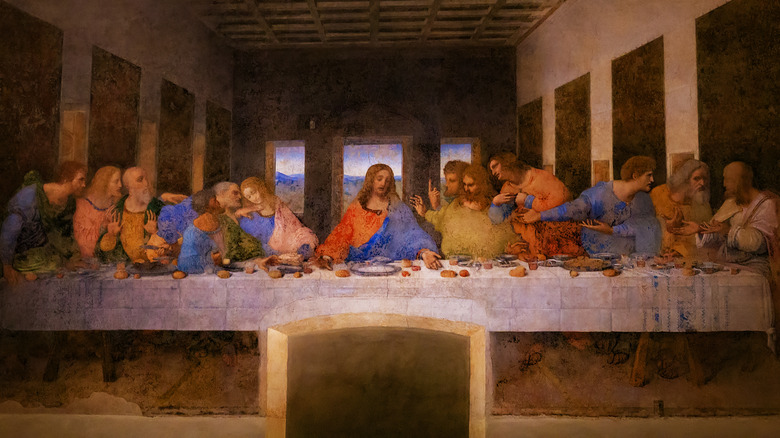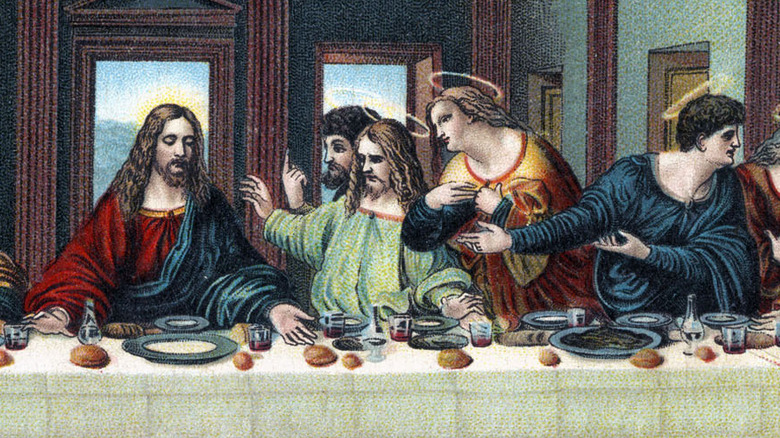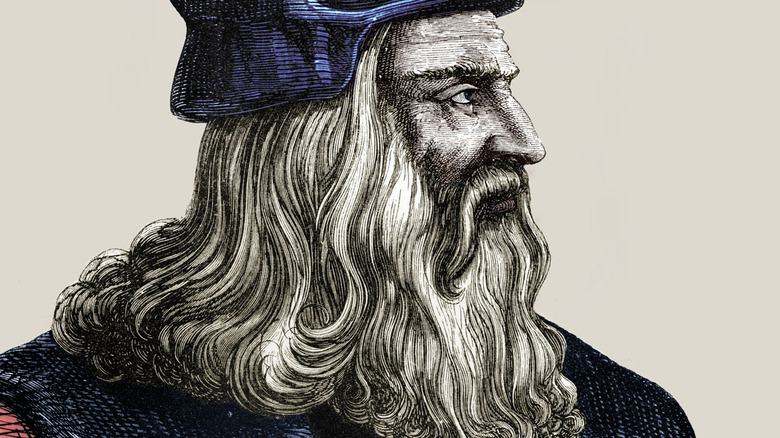Is There A Hidden Song Painted In The Last Supper?
As far as resumes go, few could surpass that of the quintessential Renaissance man, Leonardo Da Vinci. Arguably the smartest man who ever lived, Da Vinci somehow managed to juggle being a master procrastinator, painter, anatomist, and madcap inventor of many marvelous devices. Despite being a polymath adept at effortlessly slipping between the roles of an artist and engineer, few of Da Vinci's paintings have survived into the modern era, with just 17 surviving paintings that can be reliably attributed to him (via Britannica).
”The Last Supper” finished in 1498 by Da Vinci under the patronage of The Duke of Milan, Ludovico Sforza, remains one of the world's most iconic paintings. So many people travel to see "The Last Supper," which is housed in Milan's Santa Maria Della Grazie church, that visitors are confined to seeing it in 15-minute time periods to protect the painting from stray dust particles brought in by tourists (per Sightseeing Tours Italy).
However, one modern theory surrounding Da Vinci's renowned, ”The Last Supper” has left many musicologists and art historians alike pondering the full potential of Da Vinci's genius. Is it possible that Da Vinci hid in plain sight, a secret melody in one of his most famous paintings?
Hidden Layers in The Last Supper
Da Vinci's "The Last Supper," depicting Jesus of Nazareth having his last meal with his 12 apostles before his dreadful execution, is significant for its depiction of 3-D space on a flat surface (via Britannica). In the centuries since its inception, it has revealed new layers and mysteries to many who have gazed upon it.
Scholars of Leonardo da Vinci's art have debated whether Leonardo incorporated numerous components of mathematics and numerology into this painting. Many academics, for example, have referred to Da Vinci's clever inclusion of the Golden Ratio, the divine proportion found in art, architecture, and nature, within "The Last Supper."
However, musicologist Giovanni Maria Pala suggested in 2007 that the Renaissance genius may have left behind a requiem-like composition. All you had to do was follow the breadcrumbs to discover it (via CBC News).
After placing the five parallel lines of a musical staff directly across the painting, Pala realized that the positioning of the loaves of bread on the table and the hands of Jesus and the Apostles in the painting may each represent a musical note (per Live Science).
The notes initially perplexed Pala. They appeared to be in sync with the music staff's ledger lines, but the song was unpleasant and made no melodic sense. He eventually discovered the melody and order he was searching for by playing the staff from right to left. This backward series of notes produce a 40-second hymn-like melody that suits the style of Church music in Da Vinci's time (via Live Science).
Credibility of the Claims
Although some Da Vinci experts, such as Alessandro Vezzosi, admitted the theory is ”plausible," they were hesitant to throw their hat into the ring at the ”risk of seeing something that is not there," per Live Science. However, let's consider the evidence for this claim.
To begin, it is well known that Leonardo da Vinci famously wrote in reverse. He wrote from right to left since he was a natural leftie who was afraid of smudging his musings. As a result, if we read the melody notes from right to left, we may see a melodic sequence that is both appealing to the human ear and pensive.
Second, the positioning of the Apostle's hands and bread loaves on top of one another spells out several notes at once — i.e. chords — which are astonishingly harmonious with one another and assist to reinforce the melody's momentum and mood. Furthermore, Da Vinci was a noted music lover and garnered a reputation as an amateur musician and luthier (instrument maker) during his lifetime. Famous instrument designs from his sketchbooks include a magnificent string organ, and even a horse-head-styled lyre (via ABC Classic).
While there is no explicit declaration of his hidden tune in "The Last Supper," it is on brand for Da Vinci to include secret Easter eggs throughout his work, though we may never truly know if this was intentional or a coincidence. Still, this theory exemplifies the mind of a maestro who enjoyed reality on many different dimensions and should be celebrated as such. Take a listen and reach your own conclusion.


